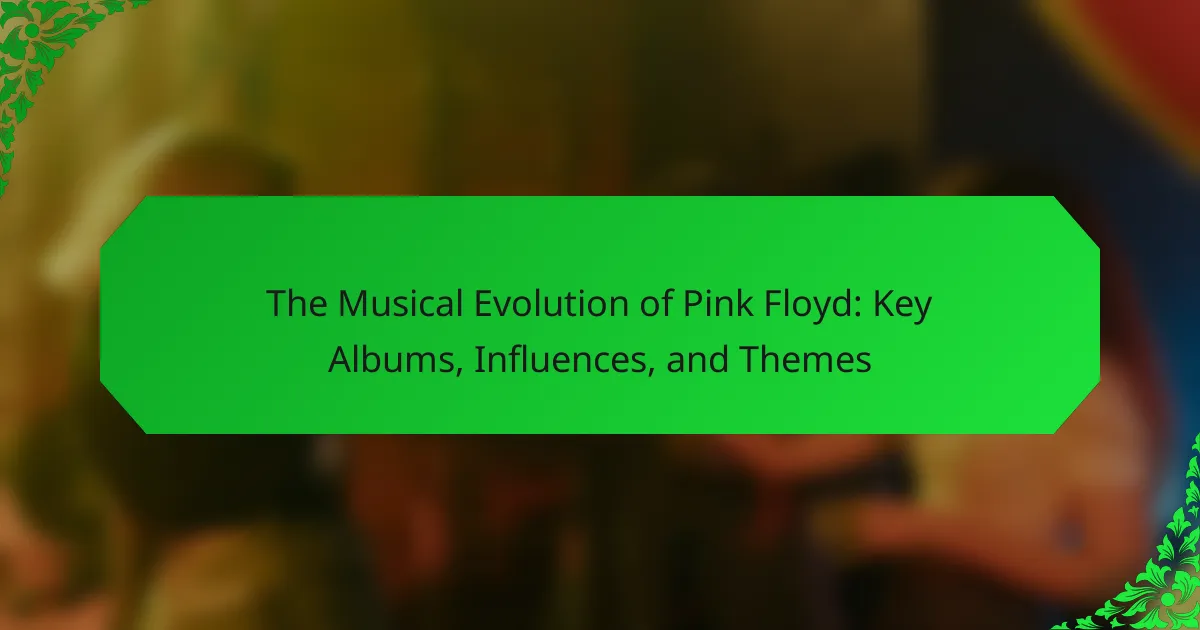Pink Floyd is a seminal rock band known for their significant musical evolution across various phases. Initially rooted in psychedelic rock during the 1960s, they transitioned to progressive rock in the 1970s, producing landmark albums such as “The Dark Side of the Moon” and “Wish You Were Here.” Their later works, including “Animals” and “The Wall,” delve into themes of alienation, mental illness, and societal issues. The band’s innovative use of synthesizers and sound effects has left a lasting impact on modern music, influencing numerous contemporary artists and the structure of concept albums. This article explores Pink Floyd’s key albums, their thematic depth, and the enduring legacy they have established in the music industry.

What is the Musical Evolution of Pink Floyd?
Pink Floyd’s musical evolution spans several distinct phases. Initially, they were a psychedelic rock band in the 1960s. Their debut album, “The Piper at the Gates of Dawn,” featured experimental sounds and surreal lyrics. As the 1970s approached, they shifted towards progressive rock. Albums like “The Dark Side of the Moon” and “Wish You Were Here” showcased complex compositions and thematic depth.
In the late 1970s, their music began to reflect personal and societal themes. “Animals” and “The Wall” highlighted political commentary and emotional struggles. The band’s sound evolved further with the incorporation of synthesizers and new technology. After Roger Waters’ departure in the 1980s, the band continued with a more polished sound in albums like “A Momentary Lapse of Reason.”
Overall, Pink Floyd’s musical evolution reflects changes in style, themes, and personnel. Their ability to adapt while maintaining a unique identity has solidified their legacy in music history.
How did Pink Floyd’s sound develop over the years?
Pink Floyd’s sound evolved significantly from their formation in 1965 to their later works. Initially, they were rooted in psychedelic rock, characterized by experimental sounds and surreal lyrics. Their debut album, “The Piper at the Gates of Dawn,” showcased this style with extended instrumentals and whimsical themes.
As they progressed, particularly with “The Dark Side of the Moon” in 1973, they incorporated more complex arrangements and thematic coherence. This album marked a shift toward progressive rock, featuring concepts of mental health and society.
In the late 1970s, with “Animals” and “The Wall,” their sound became darker and more politically charged. They utilized rock opera elements, blending narrative storytelling with their music.
By the 1980s, with “A Momentary Lapse of Reason,” they adopted a more polished sound, integrating synthesizers and a more mainstream rock approach. This evolution reflects their ability to adapt while maintaining their distinct identity.
What were the early influences on Pink Floyd’s music?
Early influences on Pink Floyd’s music included blues, jazz, and avant-garde art. The band was inspired by American blues artists like Muddy Waters and Howlin’ Wolf. They incorporated jazz elements from musicians such as John Coltrane and Miles Davis. Additionally, the experimental art movement influenced their sound and visual presentation. The band members were also drawn to the works of composers like Karlheinz Stockhausen. Their early music featured improvisation and unconventional song structures. These influences shaped their unique sound and established their place in the psychedelic rock genre.
How did the band’s lineup changes impact their musical direction?
Lineup changes in Pink Floyd significantly impacted their musical direction. The departure of Syd Barrett led to a shift from psychedelic rock to more structured compositions. David Gilmour’s arrival introduced a focus on guitar-driven melodies. The addition of Richard Wright’s keyboards enriched their soundscapes. Later, Roger Waters’ increasing creative control shifted themes towards darker, conceptual narratives. This evolution culminated in albums like “The Wall,” reflecting personal and societal issues. Each lineup change brought distinct influences, shaping their overall sound and lyrical depth.
What are the key albums that define Pink Floyd’s evolution?
The key albums that define Pink Floyd’s evolution include “The Piper at the Gates of Dawn,” “The Dark Side of the Moon,” “Wish You Were Here,” and “The Wall.” “The Piper at the Gates of Dawn,” released in 1967, marks their debut and showcases their early psychedelic sound. “The Dark Side of the Moon,” released in 1973, represents a significant shift to progressive rock and conceptual storytelling. This album topped charts worldwide and is one of the best-selling albums of all time. “Wish You Were Here,” released in 1975, reflects themes of absence and alienation, particularly in the context of former band member Syd Barrett. “The Wall,” released in 1979, is a rock opera that explores personal and societal issues, further solidifying their legacy in rock music. Each album captures a distinct phase of the band’s artistic growth and thematic exploration.
What themes are explored in “The Dark Side of the Moon”?
“The Dark Side of the Moon” explores themes of mental illness, time, and existentialism. The album delves into the struggles of the human mind, particularly through the lens of mental health issues. It captures the passage of time and its effects on life and relationships. The lyrics reflect feelings of alienation and the pressures of modern life. Additionally, the album addresses materialism and the pursuit of success. These themes resonate throughout the tracks, creating a cohesive narrative. The exploration of these themes has contributed to the album’s lasting impact and relevance.
How did “The Wall” reflect the band’s artistic growth?
“The Wall” reflected Pink Floyd’s artistic growth through its ambitious narrative and complex themes. The album explores deep psychological issues, such as isolation and trauma. This marked a shift from their earlier, more abstract works. The use of rock opera elements showcased their ability to blend music with storytelling. Additionally, the incorporation of diverse musical styles demonstrated their evolving sound. The album’s commercial success further solidified their status in rock history. Released in 1979, “The Wall” became one of their most iconic projects. It illustrated a maturation in songwriting and thematic depth. This evolution set a precedent for future concept albums in rock music.
What influences shaped Pink Floyd’s music and lyrics?
Pink Floyd’s music and lyrics were shaped by various influences, including personal experiences, social issues, and artistic movements. The band’s early work was influenced by the psychedelic culture of the 1960s. Their lyrics often reflect themes of alienation and existentialism, influenced by the socio-political climate of the time. The loss of founding member Syd Barrett had a profound impact on their sound and lyrical content. Additionally, literary influences, such as the works of George Orwell and Aldous Huxley, shaped their thematic explorations. The band’s experimentation with sound and technology also played a crucial role in their musical evolution. Overall, these influences combined to create a distinctive sound that resonated with listeners.
How did the socio-political climate of the time influence their work?
The socio-political climate of the time significantly influenced Pink Floyd’s work. The band emerged during the 1960s, a period marked by social upheaval and political change. Issues like the Vietnam War, civil rights movements, and counterculture movements shaped their themes. Their album “The Wall” reflects the disillusionment with authority and societal norms. The band’s use of political commentary in lyrics addressed the alienation felt by individuals. Events such as protests and government actions directly inspired their music. Pink Floyd’s experimentation with sound mirrored the turbulent environment. Their artistic choices resonated with listeners who experienced similar societal challenges.
What role did psychedelic rock play in their early music?
Psychedelic rock significantly influenced Pink Floyd’s early music. This genre characterized their sound with experimental instrumentation and surreal lyrics. The band’s debut album, “The Piper at the Gates of Dawn,” exemplified this style. It featured innovative use of effects like reverb and echo. Songs like “Interstellar Overdrive” showcased extended instrumental jams. These elements created an immersive listening experience. The influence of psychedelia is evident in their themes of consciousness and reality. Pink Floyd’s early music laid the groundwork for their later artistic evolution.

What are the recurring themes in Pink Floyd’s discography?
Recurring themes in Pink Floyd’s discography include alienation, mental illness, and the passage of time. The band’s lyrics often explore existential angst and human experience. They frequently address societal issues, such as war and capitalism. Concepts of isolation and disconnection are prominent in albums like “The Wall.” The theme of madness is deeply rooted in “The Dark Side of the Moon.” Additionally, the band reflects on the impact of fame and success. These themes resonate through their progressive rock sound and innovative production. Pink Floyd’s work remains influential and relevant due to these enduring themes.
How do existential themes manifest in their songs?
Existential themes manifest in Pink Floyd’s songs through lyrics that explore the nature of existence and the human condition. Their music often reflects feelings of isolation, despair, and the search for meaning. For instance, songs like “Time” discuss the passage of time and its impact on life choices. “The Wall” delves into personal alienation and the construction of emotional barriers. The band uses metaphors and soundscapes to evoke existential angst. This approach allows listeners to connect deeply with the themes presented. Overall, Pink Floyd’s work serves as a profound commentary on life’s complexities and uncertainties.
What songs exemplify the theme of isolation?
Songs that exemplify the theme of isolation include “Comfortably Numb” and “Wish You Were Here” by Pink Floyd. “Comfortably Numb” explores feelings of detachment and alienation. The lyrics convey a sense of being disconnected from reality. “Wish You Were Here” reflects longing and absence, emphasizing emotional isolation. These songs are pivotal in illustrating the theme throughout Pink Floyd’s work. They resonate with listeners through their poignant lyrics and haunting melodies. The band’s exploration of isolation is rooted in personal and societal experiences.
How does the concept of time feature in their lyrics?
The concept of time is a central theme in Pink Floyd’s lyrics. It is prominently featured in their song “Time” from the album “The Dark Side of the Moon.” The lyrics explore the fleeting nature of time and the inevitability of aging. They emphasize how time slips away unnoticed, urging listeners to reflect on their lives. The song’s iconic clock sounds symbolize the relentless passage of time. Additionally, the lyrics convey a sense of urgency to make the most of every moment. This thematic focus on time resonates throughout Pink Floyd’s discography, reflecting their philosophical outlook. The band’s exploration of time contributes to their status as pioneers in progressive rock music.
What role does visual artistry play in Pink Floyd’s music?
Visual artistry plays a significant role in Pink Floyd’s music by enhancing the emotional and thematic depth of their albums. The band is known for its innovative album covers and elaborate stage shows. Iconic visuals, such as the prism on “The Dark Side of the Moon,” symbolize complex themes like time and perception. Their use of animations and visual effects during live performances creates an immersive experience for the audience. Collaborations with artists like Storm Thorgerson have resulted in memorable imagery that complements their sound. This integration of visual elements makes their music more impactful and memorable. Overall, visual artistry is integral to Pink Floyd’s identity and artistic expression.
How did album covers contribute to the band’s identity?
Album covers significantly shaped Pink Floyd’s identity by visually representing their music and themes. The artwork often reflected the band’s innovative and experimental approach. Iconic covers like “The Dark Side of the Moon” featured symbolic imagery that resonated with listeners. This particular cover became emblematic of the band’s exploration of complex concepts such as time and mental health. Additionally, the use of surreal and abstract designs helped establish a distinct aesthetic. The covers became a visual extension of the band’s narrative and philosophical inquiries. As a result, they contributed to the band’s lasting legacy in popular culture.
What impact did live performances have on their thematic expression?
Live performances significantly enhanced Pink Floyd’s thematic expression. The band utilized elaborate visual and auditory elements during concerts. This included innovative light shows and immersive soundscapes. These enhancements deepened the emotional impact of their music. The themes of isolation and existentialism were particularly emphasized. For instance, “The Wall” was performed with a massive wall built on stage. This visual representation reinforced the narrative of alienation. Additionally, live renditions often featured extended instrumental sections. This allowed for greater exploration of thematic ideas. Overall, live performances transformed their studio concepts into a multi-sensory experience.

How has Pink Floyd’s legacy influenced modern music?
Pink Floyd’s legacy has significantly influenced modern music through their innovative sound and conceptual album structure. Their use of synthesizers and sound effects pioneered new genres, particularly progressive rock and electronic music. Albums like “The Dark Side of the Moon” and “The Wall” introduced thematic storytelling, impacting countless artists. The band’s exploration of complex themes, such as mental health and existentialism, resonates in today’s music. Many contemporary artists cite Pink Floyd as a major influence on their work. For example, Radiohead and Muse have drawn inspiration from their atmospheric soundscapes and lyrical depth. Pink Floyd’s legacy is evident in the continued popularity of concept albums in various genres. Their approach to live performances has also set a standard for visual and auditory experiences in concerts today.
What contemporary artists cite Pink Floyd as an influence?
Contemporary artists who cite Pink Floyd as an influence include Radiohead, Tame Impala, and Dream Theater. Radiohead’s frontman, Thom Yorke, has mentioned Pink Floyd’s impact on their sound. Tame Impala’s Kevin Parker has expressed admiration for the band’s psychedelic elements. Dream Theater often references Pink Floyd in their progressive rock compositions. These artists incorporate similar themes of introspection and sonic experimentation. Their music reflects the legacy of Pink Floyd’s innovative approach to sound and storytelling.
How have Pink Floyd’s musical techniques been adopted in modern genres?
Pink Floyd’s musical techniques have significantly influenced modern genres, particularly in progressive rock, electronic, and alternative music. Their use of concept albums has inspired contemporary artists to create cohesive narratives within their work. Techniques such as extended instrumental sections and atmospheric soundscapes are now prevalent in genres like post-rock and ambient music. The incorporation of synthesizers and tape effects, pioneered by Pink Floyd, can be seen in electronic music today. Moreover, their blending of various musical styles has encouraged genre fusion in modern music. Their thematic exploration of existentialism and human experience resonates with many current artists. The band’s innovative production techniques have also paved the way for advancements in studio recording. Overall, Pink Floyd’s influence is evident in the structural and thematic approaches of numerous modern musicians.
What lessons can be learned from Pink Floyd’s evolution?
Pink Floyd’s evolution teaches the importance of artistic experimentation. The band transitioned from psychedelic rock to progressive rock, showcasing their versatility. Their album “The Dark Side of the Moon” exemplified innovative studio techniques and concept albums. This shift emphasized the value of cohesive storytelling in music. Additionally, their exploration of complex themes like mental health and societal issues resonated with audiences. The band’s ability to adapt while maintaining a distinct sound highlights resilience in creativity. Their journey underscores the significance of collaboration and the impact of interpersonal dynamics on artistic output. These lessons reflect the broader potential for growth and reinvention in any creative endeavor.
How can aspiring musicians apply Pink Floyd’s innovative approaches?
Aspiring musicians can apply Pink Floyd’s innovative approaches by embracing concept albums. Pink Floyd pioneered the idea of albums with a cohesive narrative. They used soundscapes and thematic continuity to enhance storytelling. Musicians should experiment with sonic textures and atmospheric elements. This can create immersive listening experiences. Additionally, they should incorporate visual artistry into their performances. Pink Floyd’s elaborate stage shows set a standard for multimedia integration. Musicians can also explore unconventional song structures. This encourages creativity beyond traditional formats. Finally, collaboration within diverse genres can lead to unique soundscapes. Pink Floyd’s work with various artists exemplifies this approach.
What best practices can be derived from their collaborative efforts?
Best practices derived from Pink Floyd’s collaborative efforts include open communication and creative experimentation. The band members frequently shared ideas and feedback, which fostered innovation. They embraced diverse musical influences, allowing for a rich blend of styles. Collaborative songwriting sessions led to deeper lyrical themes and complex compositions. Trust among members encouraged risk-taking in their music. Their willingness to explore new technology, such as synthesizers, expanded their sound. Documenting their creative process helped refine their artistic vision. These practices contributed to their lasting impact on music.
The main entity of this article is Pink Floyd, a renowned rock band known for their musical evolution. The article provides a comprehensive overview of Pink Floyd’s transformation from a psychedelic rock band in the 1960s to a progressive rock powerhouse in the 1970s, highlighting key albums such as “The Dark Side of the Moon” and “The Wall.” It examines early influences on their music, the impact of lineup changes, and recurring themes like alienation and existentialism. Additionally, the article explores how their innovative techniques and visual artistry have influenced modern music, as well as the lessons aspiring musicians can learn from their evolution.
